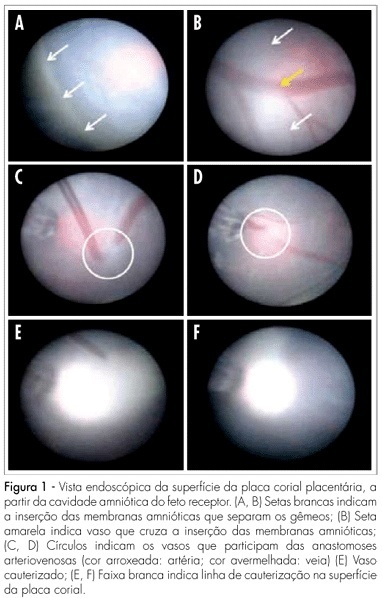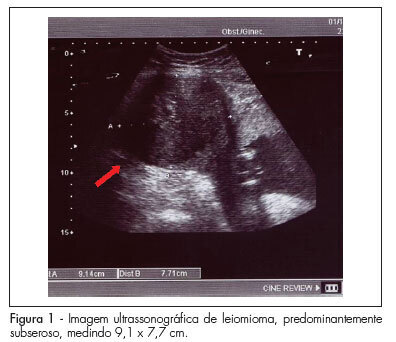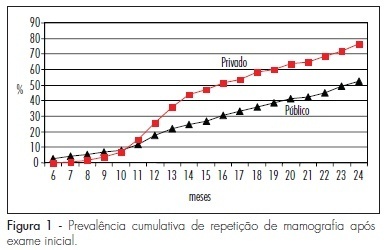Summary
Revista Brasileira de Ginecologia e Obstetrícia. 2010;32(5):214-221
DOI 10.1590/S0100-72032010000500003
PURPOSE: to describe the results of laser ablation of placental vessels for the treatment of severe twin-to-twin transfusion syndrome in an university center in Brazil. METHODS: retrospective observational study of patients treated at UNICAMP from 2007 to 2009. Laser ablation of placental vessels was performed in cases of severe twin-twin transfusion syndrome (Quintero stages II, III and IV) diagnosed before 26 complete weeks of gestation. The main variables evaluated in this series were gestational age at delivery, survival (discharge from the nursery) of at least one twin and neurological damage in survivors. Logistic regression was used to investigate the influence of cervical length, gestational age and stage of the disease (before the surgery) on the occurrence of delivery/abortion and fetal death after the intervention, and the influence on severe preterm birth and survival. RESULTS: in the whole series, at least one twin survived in 63.3% of cases (19/30). Among patients who did not have delivery/abortion after surgery, the survival of at least one twin was 82.6% (19/23). In this subgroup (n=23), mean gestational age in delivery was 31.9 weeks and neurological damage was identified in one neonate (1/31; 3.2%). Cervix length influenced the occurrence of delivery/abortion after surgery (p-value=0.008). Among seven patients (7/30; 23.3%) who carried this complication, five (5/7; 71.4%) had cervix length lower than 15 mm. Among the 23 patients who did not have delivery/abortion as a result of the surgery, the highest stages of the disease (III and IV) increased the risk of delivery prior to 32 complete weeks of gestation (p-value=0.025) and decreased the chance of survival of both twins (p-value=0.026). CONCLUSIONS: the results are similar to those available in the literature. In our series, the main factors associated with poorer results were short cervix (lower than 15 mm) and the highest stages of the disease (III and IV) at the time of the treatment.

Summary
Revista Brasileira de Ginecologia e Obstetrícia. 2010;32(5):208-213
DOI 10.1590/S0100-72032010000500002
PURPOSE: to test effectiveness and safety of the oral administration of a new misoprostol formulation in titrated doses for the induction of delivery of a live fetus at term. METHODS: an open pilot multicenter, non-randomized clinical trial was conducted from July to December 2008. A total of 30 patients with indications for induction of labor were included. The patients had a live fetus, Bishop score <6, vertex presentation, fetal weight <4,000g estimated by ultrasonography and amniotic fluid index >5. Exclusion criteria were previous uterine scar, non-reassuring fetal heart rate tracing, multiple pregnancy, fetal growth restriction, genital hemorrhage and presence of genital tumors, ulcerations or malformations. An initial dose of 20µg/hour of the oral misoprostol solution was used in the first 6 hours, and was increased progressively to 20µg/hour every 6 hours if labor did not start, up to a maximum dose of 80µg/h in the first 24 hours, maintained for additional 24 hours if necessary. RESULTS: labor was satisfactorily induced in 96.7% of patients. The interval between the first dose and the beginning of uterine contractions was 3.8±1.8 hours. The interval between the initial dose and delivery varied from 6 to 24 hours. The frequency of vaginal delivery was 80% (24 cases). Most of the patients (60%; n=18) initiated labor with a dose of 20mg/hour. Tachysystole occurred in 13.3% of women and meconium-stained fluid was detected in 20% of cases. There were two cases of Apgar scores <7 in the first minute and no Apgar score <7 in the fifth minute. CONCLUSIONS: the oral solution of misoprostol was effective and safe for the induction of labor. However, further randomized controlled trials are needed to compare this new formulation with misoprostol administered by the vaginal route.
Summary
Revista Brasileira de Ginecologia e Obstetrícia. 2010;32(5):241-246
DOI 10.1590/S0100-72032010000500007
PURPOSE: to assess the knowledge, attitude and practice of breast self-examination (BSE) of women from the municipality of São Luís (MA), Brazil, and associated socio-demographic variables. METHODS: prospective and cross-sectional study, with conglomerate sampling, in which 552 women from 14 census sections of São Luís were included during the period from January to September 2003. The knowledge, attitude and practice (dependent variables) were evaluated by means of analysis of the responses of the women as "adequate" or "inadequate". The main independent variables were: age, schooling, family income and marital and menopausal status. The χ2 test was used to determine the association between categorical variables and the measurement of the crude/adjusted Odds Ratio (OR) after multivariate analysis by means of logistic regression. RESULTS: although 1/3 of the studied population did not know about BSE, the group of women who were informed about it showed adequate knowledge (60.9%), practice (59.5%) and attitude (90%). The family history of breast cancer (8.9%) was not associated with better knowledge and practice. The media (63.6%) was found to be important in disseminating information about BSE. After multivariate analysis, women with a partner (OR=1.9) presented more adequate knowledge; women older than 50 years (OR=11.7) had a better attitude towards BSE; women with more than five years of schooling (OR=2) and with a partner (OR=1.7) were associated with a more correct practice of BSE. CONCLUSION: most of the patients know and practice the BSE in São Luís and their attitude towards the procedure is extremely positive. There was a great participation of the media in the dissemination of information concerning BSE.
Summary
Revista Brasileira de Ginecologia e Obstetrícia. 2010;32(4):198-201
DOI 10.1590/S0100-72032010000400008
Uterine leiomyomas are characterized as a benign disease and are observed in 2 to 3% of all normal pregnancies. Out of these, about 10% may present complications during pregnancy. We present a case of a pregnant patient sought emergency obstetric care at the 17th week, complaining of severe pain, presenting with painful abdominal palpation and sudden positive decompression. Ultrasonography revealed a myoma nodule measuring 9.1 x 7.7 cm; the patient was hospitalized and medicated, being also submitted to laparotomy and myomectomy due to worsening of her condition. Prenatal care revealed no further abnormalities, with resolution of gestation at 39 weeks. The newborn weighed 3,315 g, with Apgar scores of 9 and 10. In such cases, clinical treatment should always be attempted and surgery should be considered only in selected cases, mainly in the impossibility of conservative treatment or when the patient's clinical features require immediate intervention. In this case, myomectomy was effective against maternal-fetal obstetric complications.

Summary
Revista Brasileira de Ginecologia e Obstetrícia. 2010;32(4):191-197
DOI 10.1590/S0100-72032010000400007
PURPOSE: to assess compliance with the recommendations for opportunistic breast cancer screening by mammography. METHODS: 460 women from the town of Taubaté, São Paulo, Brazil, were followed-up prospectively after the index mammography, 327 of them attended by the public health system and 133 by the private system. We evaluated the prevalence of mammography repetition, the adherence rates and predictive factors associated with the current recommendations of mammographic screening. The association of the outcomes with the independent variables was studied by obtaining the risk rates (RR) and the respective 95% confidence intervals (95%CI). The adjusted prevalence rates were calculated by the COX regression model. RESULTS: although more than 90% of the studied women repeated the mammography at least once, the rate of correct compliance with the recommendations of mammographic screening, with repetition of the procedure every 24 months, was low (about 30% of the study sample). The preditive factors associated with compliance with mammographic screening were related to the unequal access to public or private healthcare services (RR=1.77; 95%CI=1.26-2.48) and to previous screening (RR=3.07; 95%CI=1.86-5.08). CONCLUSION: we concluded that compliance with the recommendations of opportunistic mammographic screening for breast cancer was low in both studied population segments.

Summary
Revista Brasileira de Ginecologia e Obstetrícia. 2010;32(4):184-190
DOI 10.1590/S0100-72032010000400006
PURPOSE: to analyze the clinical and epidemiological profile, the outcome of pregnancy and the vertical transmission of human immunodeficiency virus (HIV)-infected pregnant women receiving prenatal care at the University Hospital of Santa Maria (HUSM). METHODS: A prospective study was conducted on 139 HIV-infected pregnant women attended at the High-Risk Prenatal Care Outpatient Clinic of HUSM, during the period from August 2002 to August 2007, with at least two prenatal visits in this service. Data were collected by an interview and by filling out a research protocol during a prenatal visit. The protocol was attached to the medical records of the patient and kept until the outcome of gestation. Descriptive analysis of quantitative variables was performed using the SPSS software, version 15.0. RESULTS: The mean age of the 139 pregnant women studied was 25.6 years (±5.8), 79 (56.8%) were white, 81 (58.5%) were married or lived in a stable union, and 90 (65.0%) had less than eight years of schooling. Fifty-one percent of the pregnant women already had two or more children, with a number of children higher than the mean for the state. The infection was diagnosed during the present or a previous pregnancy in more than 70.0% cases. Sexual exposure occurred in 97.0%, and in 59.6% of cases the partner was known to be infected. During the study period, among the cases properly monitored, only one newborn (0.7%) was infected with HIV. CONCLUSIONS: Young women in a socioeconomic situation of vulnerability, with low schooling and multiparous represent the majority of HIV-positive pregnant women attended at the service. Evaluations performed during the prenatal period were relevant for the diagnosis of infection in most cases. An early diagnosis associated with proper clinical, obstetrical and psychological monitoring and with nursing care is important to provide appropriate treatment compliance and a reduction of the rates of vertical transmission.
Summary
Revista Brasileira de Ginecologia e Obstetrícia. 2010;32(4):176-183
DOI 10.1590/S0100-72032010000400005
PURPOSE: to estimate the prevalence infection of human immunodeficiency virus (HIV), human T-cell lymphotropic vírus (HTLV), hepatitis B virus (HBV), Chlamydia trachomatis (C. trachomatis) and syphilis in pregnant women, as well as risk factors associated with these infections, in Fundação de Medicina Tropical do Amazonas (FMTAM). METHODS: a cross-sectional study was carried including 674 pregnant women consecutively attended of the spontaneous demand of FMTAM between March and September 2008. Demographic, epidemiologic, socioeconomic, clinical and obstetric information have been collected through specific questionnaires. Patients had blood sample collected by peripheral venous for accomplishment of serological tests of HIV, HTLV, HBV and syphilis. Cervical secretion sample has been collected for C. trachomatis antigens detection test. The Odds Ratio has been used to evaluate risk factors associated to infections. Statistical analysis has been done with the t-Student, χ2 and Fisher's exact tests. RESULTS: the average age was 23.9 years old (SD 6.3). The observed prevalence was 0.6% to infection by HIV; 0.7% by HBsAg; 1.0% of syphilis and 2.7% by C. trachomatis. All the samples went negatives to HTLV. There were no variables associated with infection by HIV, HBV and syphilis. Significative statistically association was observed between pregnant woman with age under 20 years and of first pregnancy with C. trachomatis infection. CONCLUSIONS: the study evidenced that the prevalence infection by HIV in pregnant women assisted in FMTAM is similar to the values described in the Brazilian literature, while the prevalence by HTLV, HBV, syphilis and C. trachomatis in the studied population are below found by other authors. The main risk factor for the infection by C. trachomatis was being under 20 years old.
Summary
Revista Brasileira de Ginecologia e Obstetrícia. 2010;32(4):169-175
DOI 10.1590/S0100-72032010000400004
PURPOSE: to determine the factors associated with cesarean section in pregnancies with fetal death at a maternity hospital in Recife, Pernambuco, Brazil. METHODS: a cross-sectional study was performed, which analyzed data from the information system about mortality and medical records, from January 2005 to December 2008, of Hospital Barão de Lucena (HBL). We analyzed women with fetal death diagnosis, with gestational age of 20 weeks or more, in terms of sociodemographic characteristics, causes and types of fetal death, obstetrical precedents and birth characteristics. The associations between the variables were analyzed by the χ2 test of association and Fisher exact test, with the level of significance set at 5%. We calculated the prevalence ratio as the measure of risk and the confidence interval (CI) at 95%. Logistic regression analysis was also performed and the Odds Ratio (OR) was calculated. RESULTS: among the 258 pregnant women with fetal death, 27.5% (n=71) underwent cesarean section. After multivariate analysis, the factors that remained significantly associated with cesarean section were maternal age below 20 years (OR=0.23; 95%CI=0.06-0.85), history of one or more cesarean sections (OR=7.02; 95%CI=2.29-21.55), multiple gestation (OR=9.06; 95%CI=2.01-40.71), use of misoprostol for birth induction (OR=0.07; 95%CI=0.01-0.32), fetal death occurring during birth (OR=4.01; 95%CI=1.13-14.24), low birth weight (OR=0.33; 95%CI=0.11-0.94), presence of hypertensive disorders (OR=3.7; 95%CI=1.46-9.39) and abruptio placentae (OR=13.9; 95%CI=4.67-41.69). CONCLUSION: in HBL, the risk factors for cesarean section in pregnancies with fetal death were previous cesarean section, multiple gestation, intrapartum deaths, hypertensive disorders and abruptio placentae. The protective factors were teenage pregnancy, use of misoprostol and low birth weight.